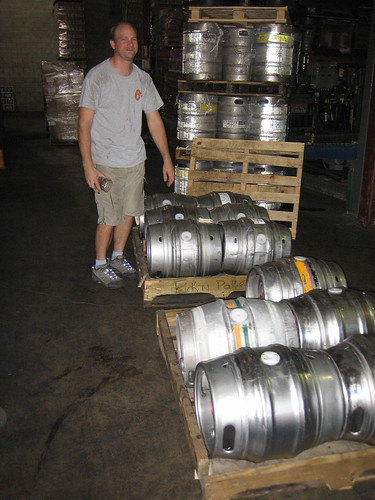
Let's do some cask math.
- A firkin
is a cask that contains 10.8 U.S. gallons (1,383.3 fluid ounces), or roughly 40.9 liters, or 86 U.S. 16-ounce pints (even though the last few would be quite 'sludgy'). In Imperial (British) measurement, that's 9 gallons. Full weight: 114 pounds, give or take. (Empty: 24 pounds.)
- A pin
is a cask that's half the volume of a firkin. It contains 5.4 U.S. gallons (691.65 fluid ounces, or 43 U.S. 16-ounce pints). That's 4.5 Imperial (British) gallons. - A kilderkin
is a cask that's twice the volume of a firkin. It contains 21.6 U.S. gallons (2,766.6 U.S. fluid ounces, or 461 U.S. 16-ounce pints). In Imperial (British) measurement, that's 18 gallons. - An English barrel
contains 36 Imperial gallons, or four times the volume of a firkin. That's 43.2 U.S. gallons (5,533.2 U.S. fluid ounces, or 345 U.S. 16-ounce pints). IMPORTANT: A U.S. barrel equals only 31 U.S. gallons (3,968 fluid ounces). - A hogshead
contains 64.8 U.S. gallons (8,299.8 fluid ounces, or 516 U.S. 16-ounce pints). That's 54 Imperial (British) gallons.
And, then, at 129.7 U.S. gallons (equivalent to 108 Imperial or British gallons), there's the wonderfully named ... butt. That's 16,601.6 U.S. fluid ounces or 1,037 U.S. 16-ounce pints. That's a big butt.
***************
But how about the outside physical dimensions of a firkin itself? For those, go: here.
**************
Finally, for some historical perspective, let's turn to British beer blogger and author Martyn Cornell —aka Zythophile.
The U.S. gallon is based on the old British "wine gallon" of 231 cubic inches, against the Imperial gallon, which is 277 cubic inches.
Wine came in pipes of 126 wine gallons, equal to 105 Imperial gallons, and a hogshead of wine was thus 63 wine gallons - halve that again, and round it down, and you end up with the U.S. barrel, 31 (US or "wine") gallons.
So a 126-(US) gallon "butt", 104 (or 105) Imperial gallons, is really a pipe.
Beer, on the other hand, in the U.K. came in butts of 108 (Imperial) gallons, which breaks down into two (54 Imperial gallon) hogsheads and three (36 Imperial gallon) barrels.
So that's why a U.S. hogshead is two U.S. barrels, but a U.K. hogshead is one and a half U.K. barrels (or three kilderkins), and why "pipe" and "butt" can be used as synonyms (being both equal to two US hogsheads, 126 U.S. gallons) in the U.S., but not in the U.K., where a pipe is three (Imperial gallons) smaller than a (108-Imperial gallon U.K.) butt.
There'll be a quiz tomorrow. It's open blog.
-----more-----
- U.S. to English volume conversions.
- One U.S. gallon holds 128 U.S. ounces, or 3.785 liters.
- An Imperial (British) gallon, on the other hand, holds 153.7 U.S. ounces, or 4.546 liters.
- So, one Imperial (British) gallon is the equivalent of 1.2 U.S. gallons. Another way of saying that would be that one U.S. gallon is the equivalent of 0.83 Imperial gallons.
- Other handy volume measurements









No comments:
Post a Comment
Comment here ...